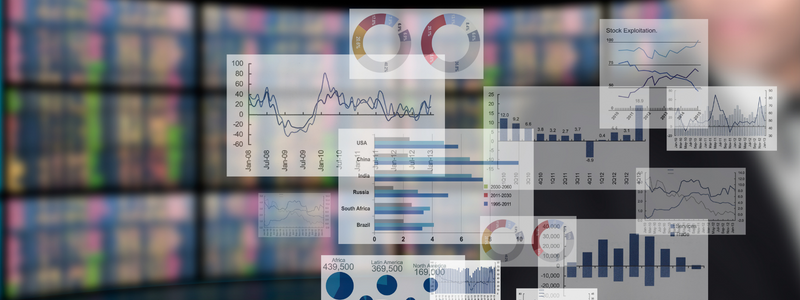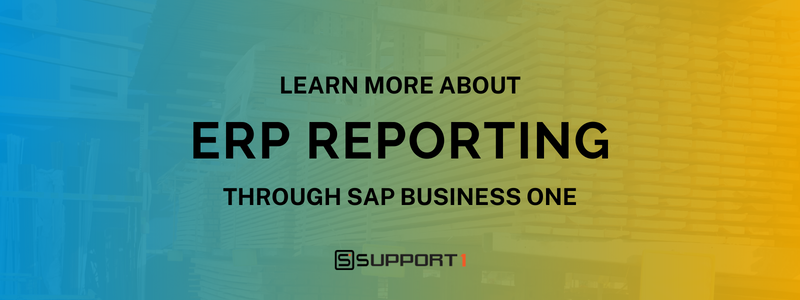ERP Reporting
Enterprise Resource Planning (ERP) reporting is a critical component of any ERP system, enabling businesses to gather data from different departments and processes and turn it into valuable insights. This article will explore the concept of ERP reporting, its benefits, types, tools, and best practices— so you can make the most out of your ERP strategy.

Benefits of ERP Reporting
The success of any business in today’s competitive environment is heavily dependent on how effectively they manage its resources, processes, and overall operations. You can have the best business idea in the world, but if you can’t execute it, you’ll fall behind in delivering your value proposition. ERP software has emerged as a powerful solution to streamline business processes and keep the entire organization on the same page. Among the many capabilities of a robust ERP system is its reporting, which can enhance how you use your ERP to improve visibility into your performance.
Improved Visibility with Real-Time Data
ERP reporting can provide real-time visibility into your operations. With access to up-to-date information across departments and locations, businesses can track progress, monitor performance, and respond quickly to any issues that arise. This enables organizations to be proactive in addressing potential problems early and contributes to increased agility and responsiveness in a fast-paced and ever-changing business landscape.
Data-Driven Decision Making
In the era of big data and fast-moving technological updates, your organization can no longer rely on guesswork and assumptions to make critical decisions. Competitors are constantly innovating and pushing the bar further in streamlining operations through targeted data. That’s why investing in a robust reporting infrastructure is pivotal in helping you keep up with the latest and greatest in business management.
ERP reporting provides accurate and timely information, enabling your organization to make informed decisions based on data-driven insights. By accessing historical data and analyzing trends, managers can better understand the cause-and-effect relationships that govern their operations. Creating standardized reports that adapt to the changing needs of your business can help your leadership digest information concisely and targeted way. This visibility increases the likelihood of making the right decisions and leads to better risk management and strategic planning.
Identifying Inefficiencies for Cost Savings
One of the key benefits of ERP reporting is its ability to identify inefficiencies in business operations. By analyzing data and monitoring performance, your company can uncover areas where resources are wasted, or processes are unnecessarily complex. This allows your organization to reduce costs and optimize operations by addressing these challenges head-on. The outcome is a more streamlined, cost-effective, and profitable business.
Building a Foundation for Continuous Improvement
The benefits of ERP reporting don’t end at the initial implementation. By providing businesses with a wealth of data and insights, ERP systems lay the groundwork for a culture of continuous improvement. As organizations grow and evolve, the data collected by the ERP system can be used to identify new opportunities for optimization and growth. This ongoing process ensures that businesses stay ahead of the curve and maintain their competitive edge in the industry.

Types of ERP Reporting
With an ERP system, you can leverage different types of reporting to gain insights into your business performance and make decisions accordingly.
Standard reports
Standard reports provide your business with specific data based on their requirements, such as sales figures, customer profiles, inventory levels, etc. You can use this information to make decisions on critical business challenges, from product development to marketing strategies. Your ERP vendor typically designs standard reports, offering a great starting point for organizations looking to get started with ERP reporting.
Ad-hoc Reports
Ad-hoc reports allow your business to create custom reports tailored to your needs. These reports go beyond the standard by giving your team customizable visibility into your organization. Ad-hoc reporting enables users to select data points, choose a format, and design a report layout according to their preferences. That means if you have a unique business model, you can plug in your specific data points and get the output data that drills into the nitty gritty not always seen in standard reports.
This type of reporting is also beneficial when your team needs quick answers or specific information that isn’t available in standard reports. Ad-hoc reporting allows your company to create reports quickly without waiting for support from IT teams or external vendors.
Dashboards
Dashboards are graphical representations of key performance indicators (KPIs) your operations teams can access in real-time to monitor performance and take corrective actions promptly. Dashboards typically include visual elements such as graphs, charts, tables, etc., which help present complex data in an easy-to-understand manner. Dashboards also allow users to quickly drill down into detailed information to identify opportunities and address issues before they become more significant problems.
ERP Reporting Tools
Below is a breakdown of different types of ERP reporting tools to consider, with examples of leading software in the space.
Built-in Reporting Tools
ERP systems typically have built-in reporting tools that offer basic functionality to cover the most common reporting requirements. These tools are designed to work seamlessly with your ERP system and provide real-time data to help track your business performance. They often include standard reports for financial statements, inventory management, sales forecasting, and more. Some of the most popular built-in ERP reporting tools are Crystal Reports, SQL Server Reporting Services, and Oracle Report Builder.
Third-party Reporting Tools
While built-in reporting tools can effectively cater to basic reporting needs, some organizations require more advanced capabilities or additional functionalities. Third-party reporting tools offer a range of specialized features to enhance the reporting power of your ERP system— making it easier for you to generate interactive and dynamic reports that can be easily shared and accessed across the organization.
Third-party tools are developed by independent vendors and are designed to integrate with various ERP systems. Some popular third-party reporting tools include Microsoft Power BI, Tableau, and QlikView. These tools can help your business generate interactive and dynamic reports that can be easily shared and accessed across the organization.
Business Intelligence (BI) Tools
Business Intelligence (BI) tools can offer a comprehensive solution for organizations with highly advanced reporting needs. BI tools go beyond traditional reporting capabilities, enabling your business to gather, analyze, and visualize data from various sources to generate actionable insights at scale.
BI tools can help organizations identify trends, discover hidden insights, and make data-driven decisions to improve overall performance. They often come with advanced analytical capabilities, such as machine learning algorithms and predictive analytics, to help your business forecast trends and make proactive decisions. Some popular BI tools are IBM Cognos Analytics, SAP BusinessObjects, and Microsoft Power BI.

Best Practices for ERP Reporting
To take full advantage of all the features and benefits, it’s essential to follow best practices for ERP reporting. Below are some of the most critical best practices to keep in mind when carrying out your ERP reporting strategy.
Define Clear Goals and Objectives
The first step of any strong reporting process is to define clear goals and objectives. This means you need to determine what data points you want to include in your business reports, what format they should be presented in, and at what frequency they should be produced. These business goals should be aspirational and achievable while also being trackable through your ERP reporting. Without this clarity, creating meaningful reports useful for decision-making in your operations will be challenging.
Select Relevant Data Points
Once you’ve defined the goals and objectives of the reporting process, it’s time to select relevant data points that align with those goals and objectives. The goal here is not to include every single piece of data available. Instead, focus on the most critical data points that move the needle on decision-making. In addition, try to avoid having too much irrelevant data— which can clutter up the report and make it more difficult for decision-makers to draw meaningful conclusions from it. Your KPIs can tie your business together— whether it’s monthly recurring revenue (MRR) or inventory levels.
Use Visualization Tools
Visualization tools such as charts and graphs can make it easier for your organization’s decision-makers to understand complex data sets quickly. Using these visualization tools within your reports makes spotting trends or anomalies within their operations easier without wading through raw data pages. Moreover, visualization tools can help identify areas where improvements can be made or resources may need reallocation to maximize productivity.
Monitor Performance
Monitoring ERP performance regularly and making necessary adjustments to stay on top of their operations is a key practice high-performing operations teams employ. ERP systems provide your operations team with real-time insight into critical processes, allowing you to stay ahead of any potential issues before they become a larger problem. You can use this information regularly to adjust your processes.
SAP Business One Gives You Access to Company-Wide Reporting
As an organization, it’s essential to have a comprehensive view of your operations— especially with increasingly complex processes as you scale. SAP Business One is an ERP system designed for small and medium-sized businesses that provides access to valuable insights into their operations. With SAP Business One’s powerful ERP reporting capabilities, you get access to real-time analytics that provide valuable insights into your operations. As a result, you can make more informed decisions that increase efficiency and improve customer relationships.
With the help of Support One, you can integrate the premier ERP system in a manner that allows you to make the most of analytics and reporting. From seamless reporting and comprehensive analytics to efficient business processes, SAP Business One will help you drive growth and success by helping increase accuracy, visibility, and speed. Whatever your needs are, Support One will provide tailored solutions that fit your business goals. Start your journey today – let Support One put you at the forefront of ERP technology.










